3. How Businesses Generate Revenue With Stablecoins

You’ll Learn
- The secret to stablecoin profit — how market leaders (Tether and PayPal) generate consistent revenue through interest income, transaction fees, and ecosystem integrations.
- Which revenue models work — the mechanisms that turn stablecoins into reliable financial engines for businesses and protocols: stability fees, liquidation profits, and more.
- How leading companies (i.e., Stripe and innovative DAOs) remodel payments, treasury management, and operational efficiency.
- How to apply practical strategies for earning competitive yields on stablecoins using DeFi protocols, real-world asset platforms, and centralized accounts.
- Which steps you can take to harness stablecoins for business growth, market expansion, and financial sustainability in the evolving blockchain economy.
You now have a solid understanding of what makes stablecoins a meaningful asset in the business world and how they connect Web3 and the real world. We covered the reasons why stablecoins have achieved product-market fit, analyzed where their liquidity resides, and explored which blockchain networks are growing fastest. It’s time to shift focus.
Choosing the right blockchain to build on is essential for Web3 entrepreneurs, startups, and businesses. Sure, it’s critical to identify where stablecoin ecosystems thrive, but it’s equally important to understand how stablecoins generate revenue.
In this chapter, we’ll analyze how stablecoins create consistent cash flows and scalable financial opportunities. We dive into the revenue models of stablecoin protocols, so you’ll understand the disruptive mechanisms that make them a profitable business opportunity.
Read on as we explore the various stablecoin revenue models and discover how they unlock opportunities for entrepreneurs and businesses.
We’ll now show you why the stability of onchain earnings and profits’ stability matters. Our first stop is Tether, where earned interest on their USDT collateral enables the company to generate consistent cash flows. Later, we’ll break down revenue opportunities for utilizing and leveraging stablecoins (e.g., by using lending protocols).
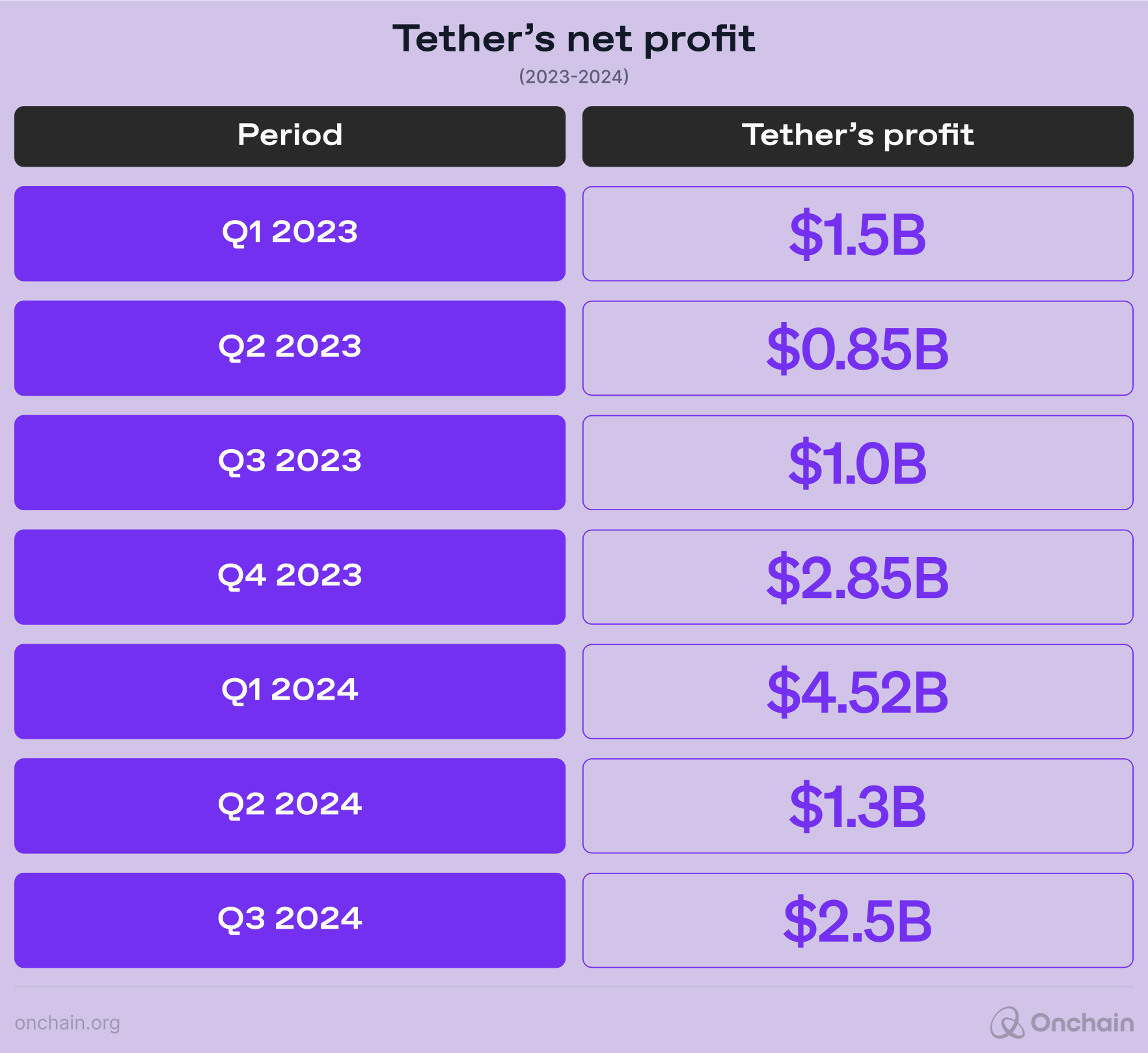
It’s too late to become an early part of Tether and benefit from their record-breaking profit per employee ($30 million to $120 million, depending on the source). However, it’s still early in the stablecoin ecosystem development. In fact, this is still only the beginning.
You may be interested in building your own stablecoin project. Or simply want to implement stablecoins in your business operations. Wherever your passion leads you, the stablecoin sector is full of recurring revenue streams you can incorporate into your project, and we’ll break them down for you here.
3.1 The business models of stablecoin protocols
Tether (USDT)
Tether (USDT) is a prime example of a highly centralized and profitable stablecoin company. Tether generates significant revenue through interest earned on its substantial collateral reserves. This capital fully backs their USD stablecoins at a 1:1 ratio.
With the largest stablecoin by market capitalization, Tether strategically invests its backing reserves in low-risk, interest-bearing assets and thereby ensures their revenue generation.
- U.S. Treasury bills (T-bills): 81% of Tether’s reserves are invested in short-term T-bills. These highly liquid government securities offer a reliable and steady revenue stream.
- Cash equivalents: Tether also allocates funds to other cash equivalents, such as money market funds (6.4%) and commercial paper (11.3%). This collateral diversification provides additional interest earnings while ensuring the necessary liquidity to meet USDT redemption requests.
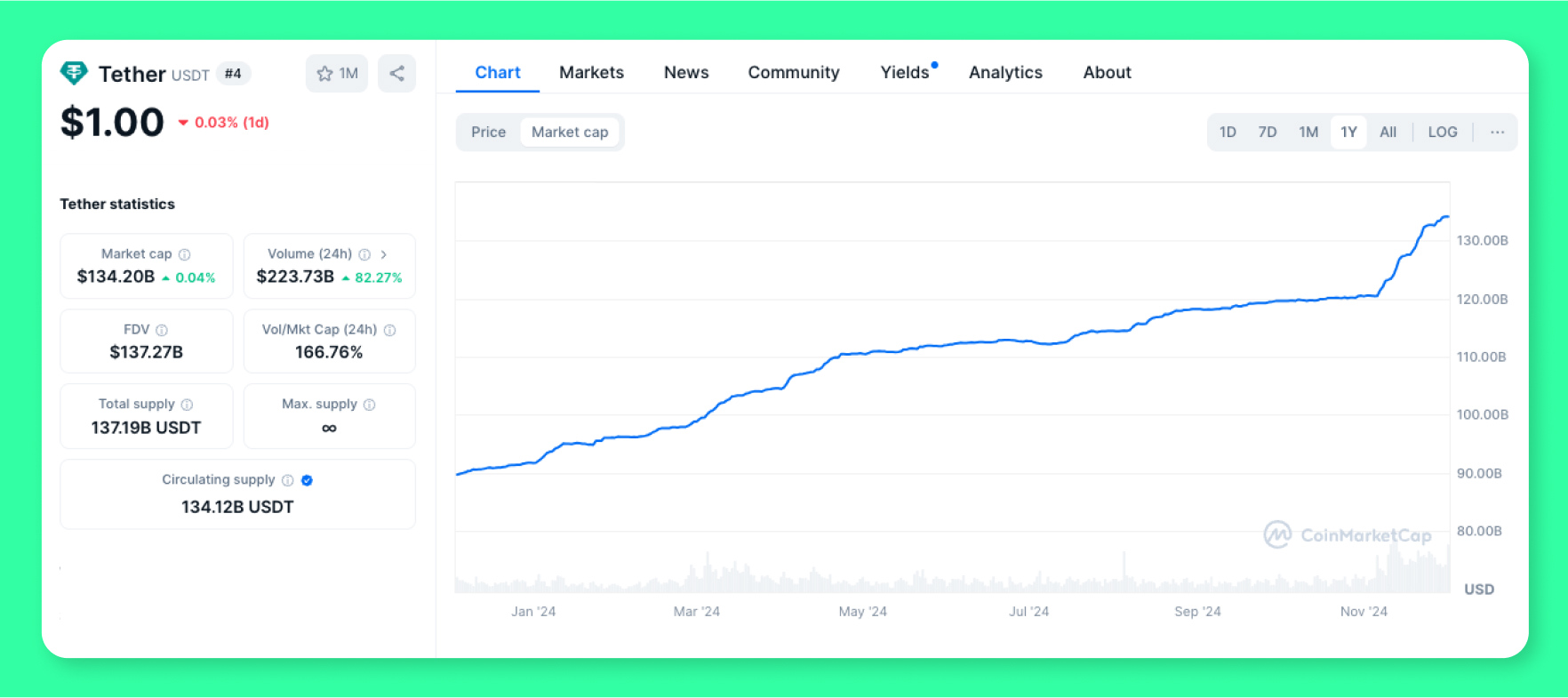
The sheer magnitude of Tether’s reserves allows for high profitability even with modest returns. With a market cap exceeding $120 billion in October 2024, even a meager 2% annual percentage yield (APY) on reserves would generate over $2.4 billion in yearly revenue.
Transaction fees
Another significant revenue stream for Tether is fees for minting and redeeming USDT:
- Minting fees: When new USDT tokens are created (minted), Tether charges a 0.1% fee (with a $1,000 minimum) on the minting total. To mint USDT, new users must complete a $150 verification process. Approved accounts can then exchange USD for USDT. This fee structure is targeted toward institutional clients who want to mint larger sums of USDT. For example, a $1 million USDT mint would incur the baseline $1,000 fee, making smaller mintings more expensive on a USD-to-USDT basis.
- Redemption fees: Users who wish to redeem their USDT for USD are also subject to fees. These fees can vary but typically range from 0.1% to 3% of the redemption amount.
Profitability
Tether’s profitability is rooted in several key factors:
- Massive reserves: With over $125 billion in assets under management (AUM), Tether’s earned interest income is unparalleled in the stablecoin space.
- Stablecoin liquidity: USDT is the most liquid stablecoin in the market. This high liquidity maintains demand for the stablecoin and ensures a constant flow of minting/redemption fees.
- Market dominance: With the largest stablecoin by market cap, Tether benefits from USDT’s network effects and economies of scale.
- Diverse revenue streams: By combining interest income with transaction fees, Tether has created a robust and diversified revenue model.
- Low operational costs: Despite its massive AUM, Tether operates with a relatively small team and uses efficient blockchain technology. This keeps operational costs much lower than traditional financial (TradFi) institutions.
In the first half of 2024, Tether reported a $5.2 billion profit, largely driven by its T-bills earning a 4.72% yield. While the impact of declining interest rates on revenue remains uncertain, Tether generates an astounding ~$32 million per employee. Its reputation as one of the most profitable and well-run Web3 companies is certainly deserved.
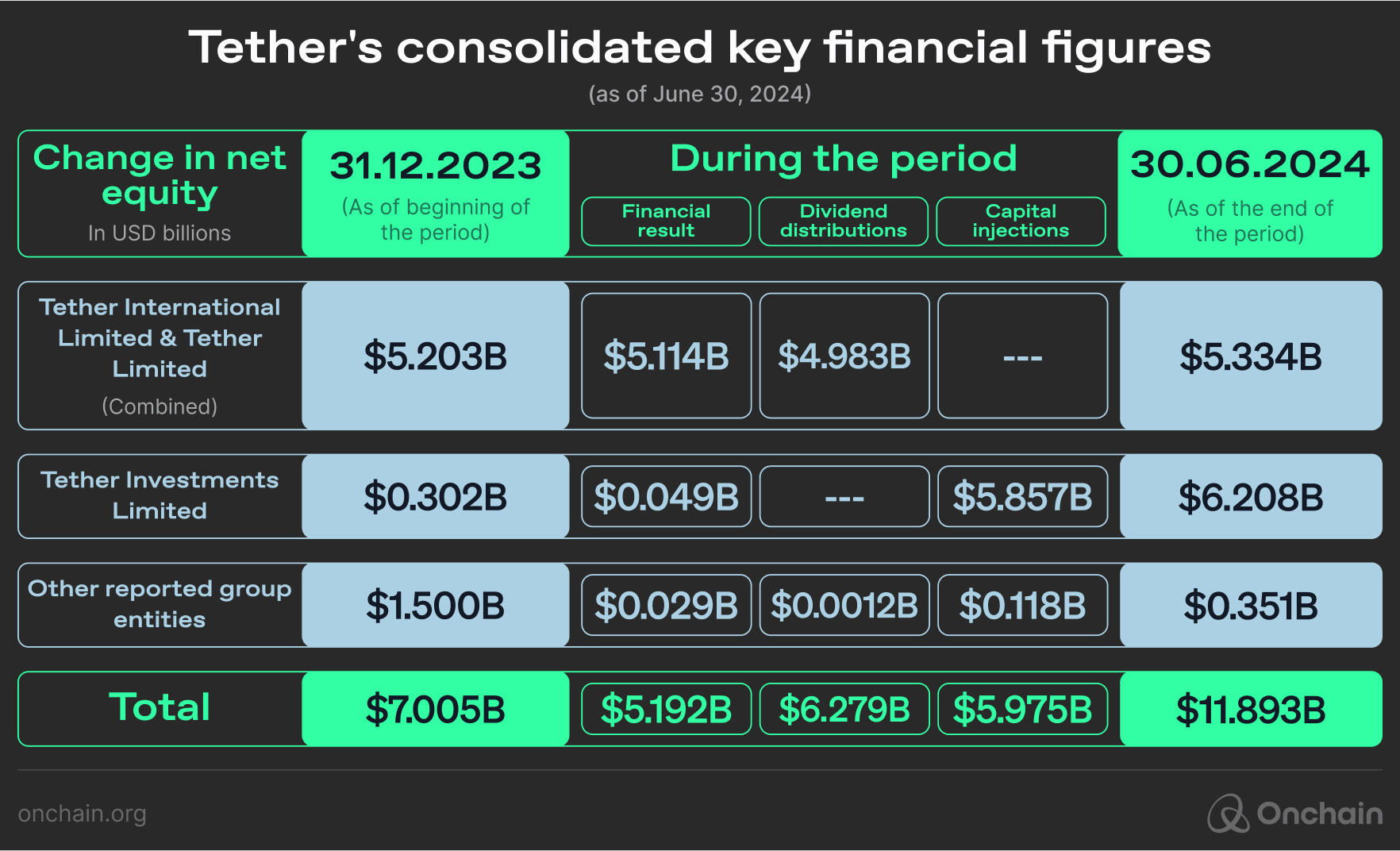
Survey insights
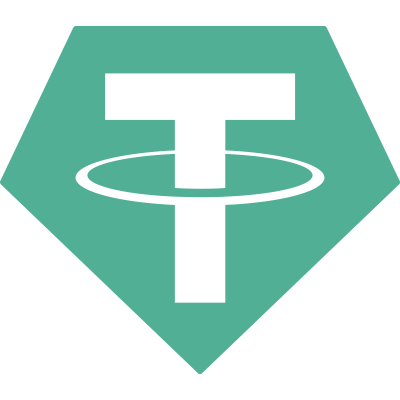
Insight 2.3: Across both emerging and advanced economies, the dominant stablecoin is USD and Tether.
Despite the differences, Tether and USD Coin (USDC) dominate the stablecoin landscape in rising and established economies. Interestingly, Tether leads in both regions.
Among respondents:
- Businesses in advanced economies primarily use USDT.
- Businesses in emerging economies also identified Tether as their primary stablecoin.
This reflects the significant role Tether plays in enabling transactions globally, particularly as it maintains its lead in liquidity and adoption.
Despite the differences, Tether and USD Coin (USDC) dominate the stablecoin landscape in rising and established economies. Interestingly, Tether leads in both regions.
Among respondents:
- Businesses in advanced economies primarily use USDT.
- Businesses in emerging economies also identified Tether as their primary stablecoin.
This reflects the significant role Tether plays in enabling transactions globally, particularly as it maintains its lead in liquidity and adoption.
PayPal (PYUSD)
In August 2023, PayPal debuted its own in-house stablecoin, PayPal USD (PYUSD). Its entry into the stablecoin sector marked a significant moment for both the financial technology (FinTech) industry and the crypto ecosystem. By October 2024, PYUSD had shown remarkable growth and adoption, positioning PayPal as a formidable player in the stablecoin space.
Market performance and growth:
PYUSD has experienced explosive growth since its launch:
- Market capitalization: Surpassed $1 billion in August 2024, followed by a drop to $647 million (as of October 22, 2023).
- Year-over-year growth: Approximately 339% growth from launch to August 2024.
- Recent growth: 45% month-on-month increase between July and August 2024.
- Market position: As of October 2024, PYUSD ranks as the 6th-largest stablecoin with a $647 million market cap.
Key drivers of PYUSD growth
1. Multi-chain presence:
- PYUSD initially launched on Ethereum.
- PYUSD expanded to Solana in May 2024, leading to significant growth.
- 60% of PYUSD circulation is on Solana.
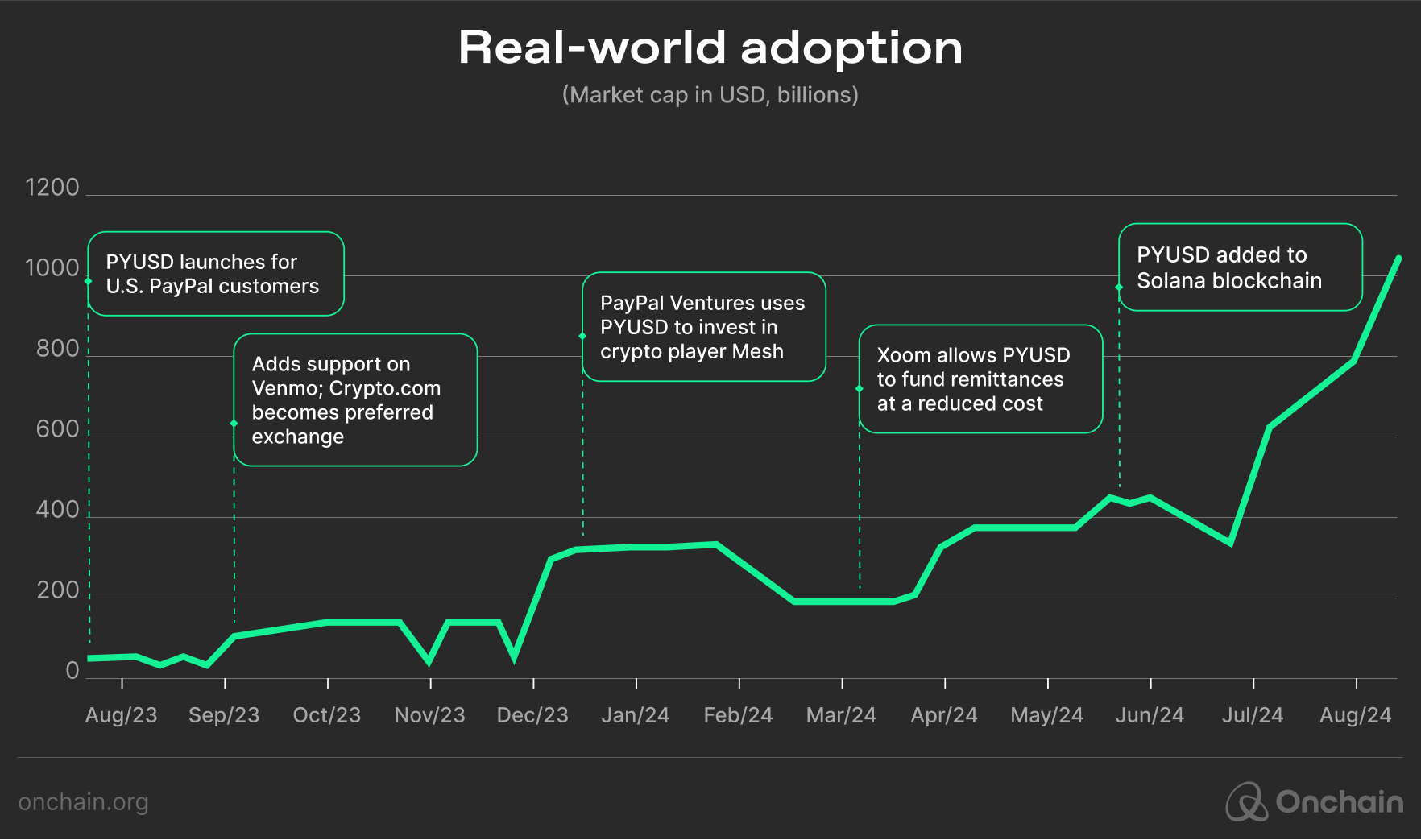
2. Exchange listings:
- PYUSD was added to major cryptocurrency exchanges just months after its launch.
Popular trades include swaps with USDC and USDT.
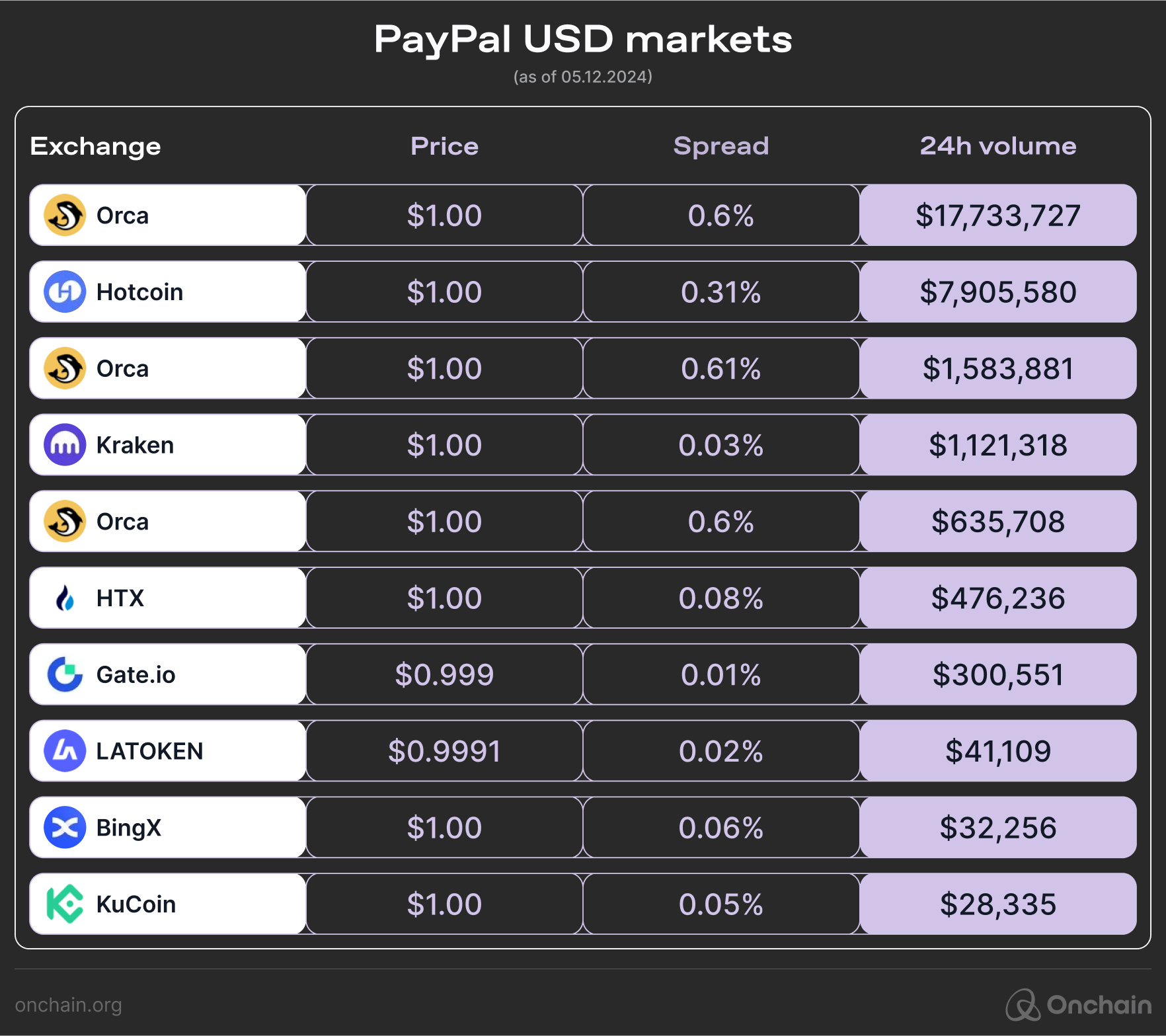
Integration with PayPal services:
- In March 2024, Xoom (PayPal’s remittance service) enabled PYUSD for cross-border transfers.
- This removed the fee margin for PYUSD-funded transactions, reducing remittance costs by 25%.
3. Incentive programs:
- Platforms like Kamino, Drift, and Marginfi offer enhanced rewards for Solana-based PYUSD deposits.
- Anchorage Digital announced stablecoin rewards for institutions depositing PYUSD.

I believe these incentives are designed to be short-lived rather than lasting, with the primary aim of increasing PYUSD circulation and motivating users, particularly newcomers, to engage actively in the Solana ecosystem.
- Ambreen Khral, Market Researcher, Onchain
While it’s premature to comment on PayPal’s specific business model, we will likely see them adopt revenue streams implemented on other stablecoin platforms.
1. Interest income:
- PayPal likely earns interest on the collateral reserves backing PYUSD.
- With over $700 million in circulation, even modest interest rates could generate significant revenue.
2. Transaction fees:
- While blockchain transaction fees go to network validators, PayPal may charge fees for minting/redeeming PYUSD.
- PayPal could integrate PYUSD with its existing services for additional free revenue opportunities.
3. Foreign exchange (FX) fees:
- PYUSD could become a growing source of FX fee revenue if recipients choose to receive other tokens. This conversion also creates arbitrage revenue opportunities (Innopay, 2023).
4. Ecosystem growth:
- PYUSD’s integration into PayPal’s vast user base could drive the adoption of other PayPal services.
Sky Protocol (USDS)
USDS is the newly introduced stablecoin of the Sky ecosystem (formerly known as MakerDAO), complementing the popular DAI token. Launched on September 18, 2024, USDS represents a significant evolution in the decentralized finance (DeFi) space. As of October 2024, USDS’ market cap surpassed $1.25 billion.
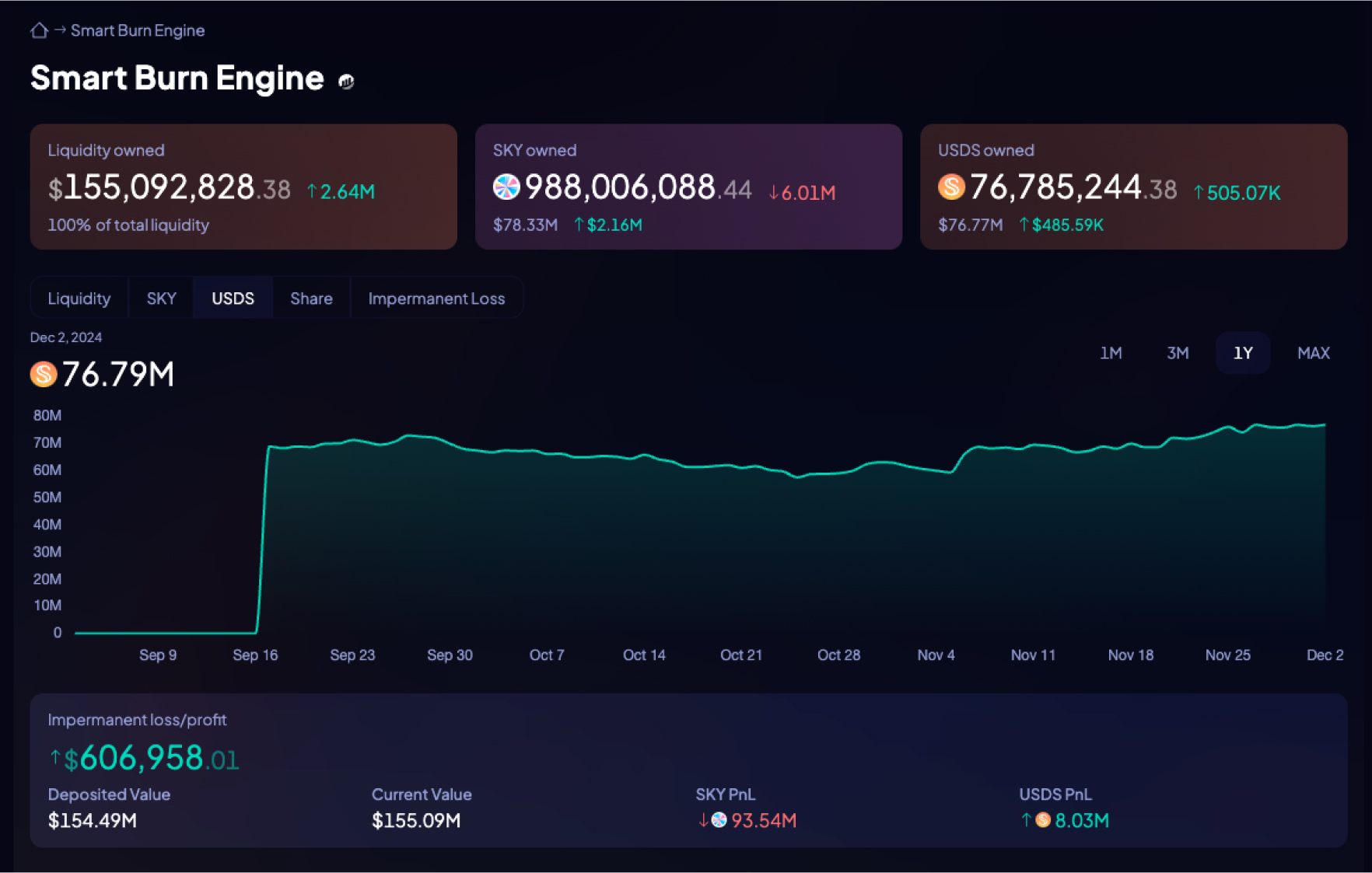
Key drivers of growth
- Collateral options expanded to include real-world assets (RWAs).
- Integration of tokenized T-bills and corporate bonds.
2. Cross-chain presence:
- Initially available on Ethereum, it expanded to Layer 2 (L2) solutions like Optimism, Arbitrum, and Solana.
3. DeFi integration:
- Remains a cornerstone of major DeFi protocols across multiple blockchains.
4. Institutional adoption:
- Increased adoption for cross-border settlements among crypto-native businesses.
- USDC has seen significant adoption for cross-border settlements, particularly among crypto-native businesses. For instance, Crypto.com, a major cryptocurrency platform, has integrated USDC into its payment ecosystem, enabling more efficient settlement processes.

Our goal with USDS has been to push the boundaries of what blockchain technology can achieve while making those benefits accessible to everyday people. While cutting-edge technology is fascinating, it only matters if it leads to real-world impact. We want to ensure that regular users can enjoy these advantages, which is why we've designed USDS to offer a savings rate managed by the Sky ecosystem that taps into both DeFi and traditional finance opportunities.
- Rune Christensen, Co-Founder, Sky Protocol
Business model and revenue streams
1. Stability fees:
- Users pay fees (~1.5%/year) when they generate USDS against their collateral.
- In 2024, stability fees generated over $259 million in revenue.
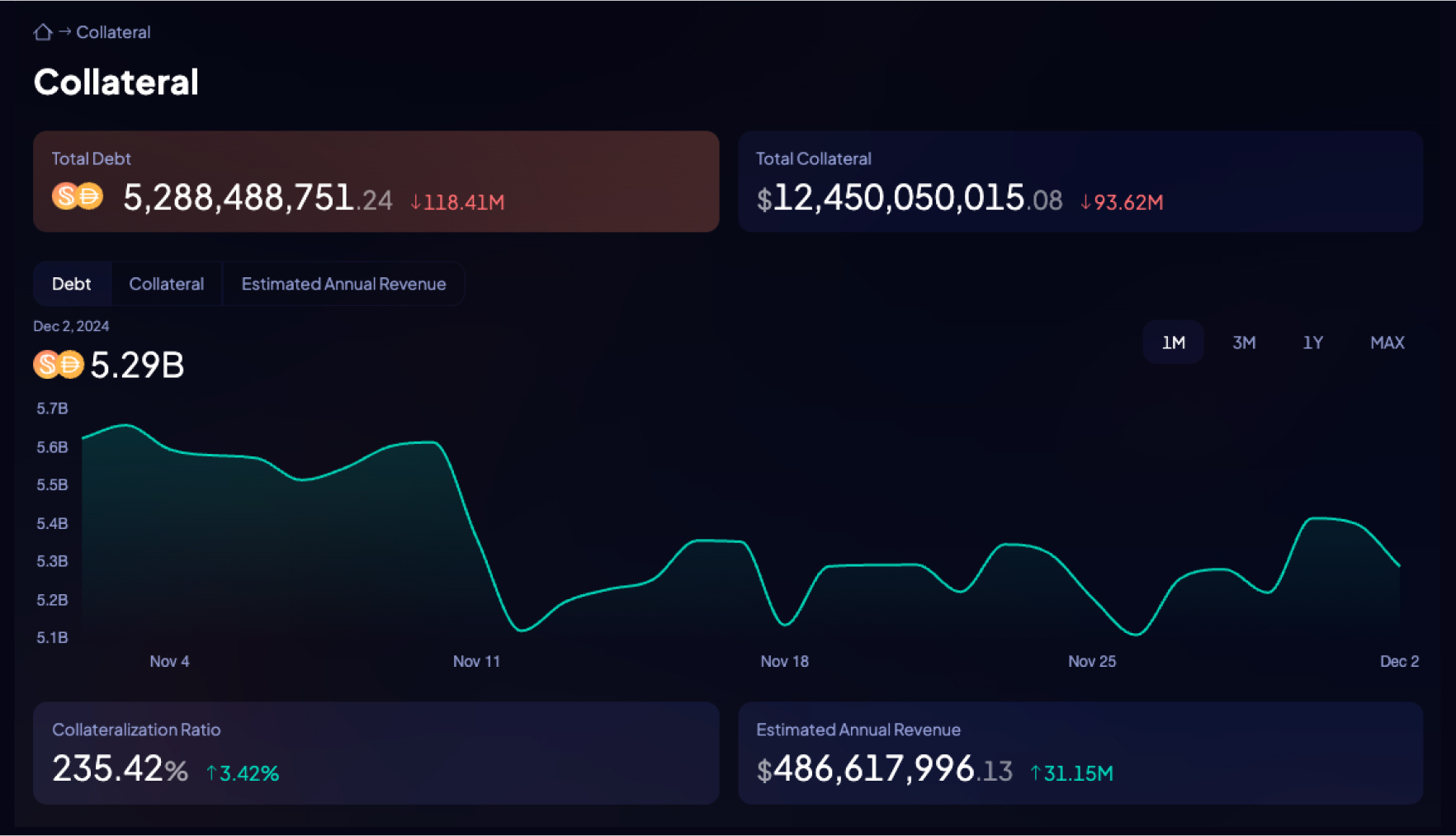
2. Liquidation fees:
- Fees are collected from the liquidation of undercollateralized positions.
- Liquidation fees contributed approximately $193 million to protocol revenue in 2024, whereas USDS lost $10 million.

3. Yield from RWA collateral:
- Interest earned on tokenized RWA collateral.
- Estimated to generate $75 million at 4.5% APY by the end of 2024.
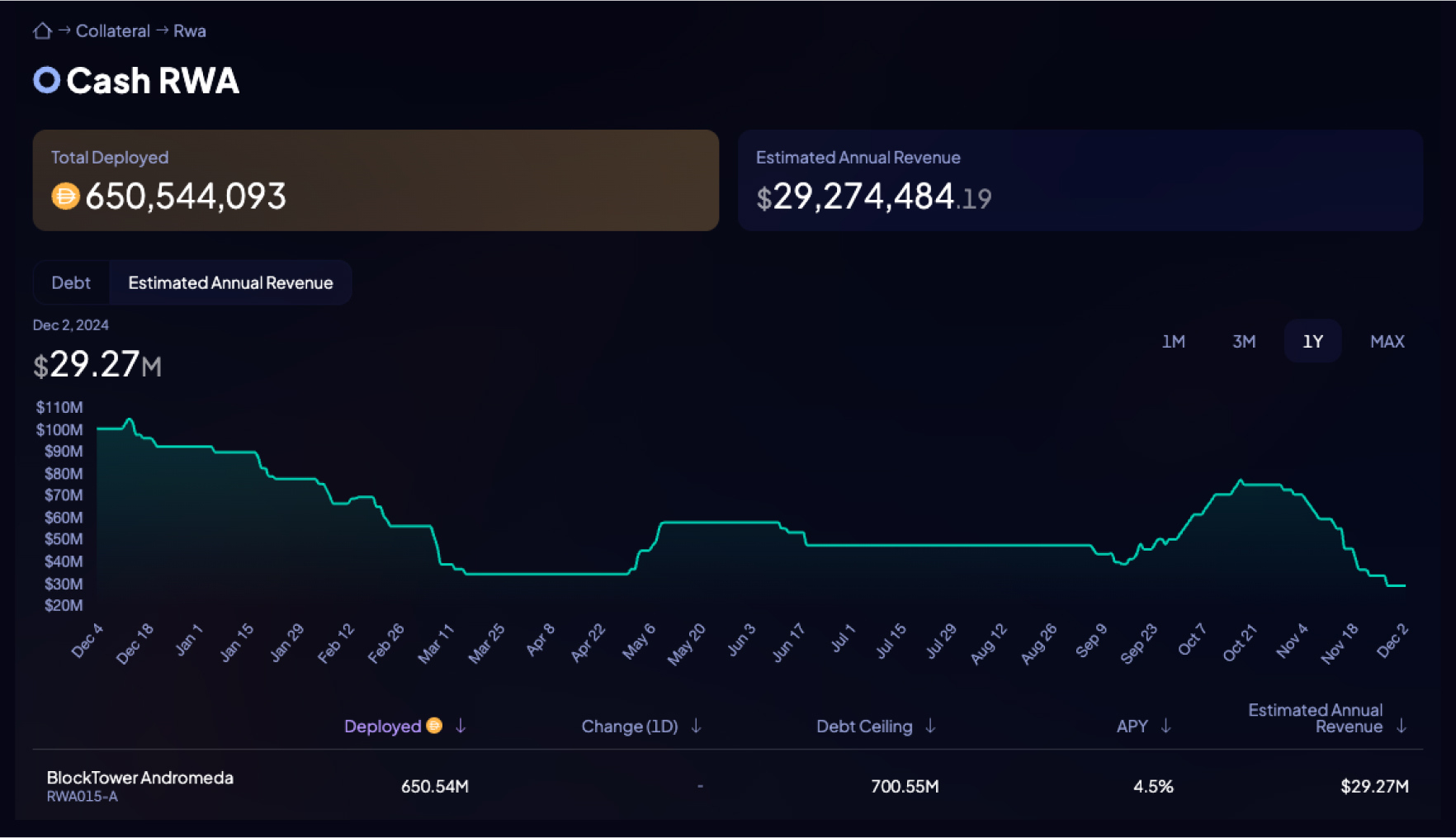
3.2 Comparing different business models of stablecoin protocols
To effectively analyze and compare various stablecoin business models, we’ve developed a comprehensive framework that examines key operational aspects, revenue mechanisms, and stability strategies.
Dubbed the Stablecoin Business Model Analysis Matrix (SBMAM), this framework provides a comprehensive overview of different protocols’ approaches to maintaining a stable USD peg while generating recurring revenue.
Analysis and insights
1. Revenue model evolution
Tether generates income from interest on its $125+ billion reserves. However, this income is tied to fluctuating interest rates. PYUSD earns reserve interest and utilizes PayPal’s payment ecosystem. Sky Protocol relies on DeFi-native revenue streams, such as stability and liquidation fees, providing resilience across market cycles.
2. Collateral strategies and transparency
Tether’s focus on T-bills has improved transparency and boosted confidence, though this revenue is affected by U.S. monetary policy. PYUSD enjoys PayPal’s reputation but lacks reserve transparency. Sky Protocol’s innovative multi-collateral model, including RWAs, enhances stability but adds complexity.
If you want to learn more about this topic, check out the Onchain “Real-World Assets for Real-World Purposes“.
3. Stability mechanism sophistication
Tether and PYUSD rely on in-house mechanisms for quick responses but face risks from centralized failure points. In contrast, Sky Protocol’s algorithmic system offers decentralized resilience but is vulnerable to extreme market stress. For example, during the March 2020 crash, MakerDAO (rebranded to Sky Protocol in 2024) faced mass liquidations and network congestion. The DAO ended up losing $4.5 million in DAI before stabilizing with centralized USDC collateral. These trade-offs emphasize the delicate balance between stability, adaptability, and risk in different models.
4. Market positioning and growth
Tether maintains market dominance in crypto trading due to its deep liquidity. PYUSD integrates with PayPal’s vast user base, bridging TradFi and DeFi. Sky Protocol’s focus on cross-chain capabilities positions it for strong DeFi growth.
3.3 Implementing stablecoins in business operations

The true strength of blockchain isn't about solving global issues like hunger. It's about revolutionizing how we transfer value – making it faster and more transparent.
- Dr. Ananya Shrivastava, Research Analyst, Onchain
If you want to offer customers a crypto payment option, this section is for you! The following study explores how businesses can leverage Stripe’s payment solution to enhance their operations, manage payments, and reach new markets. The leading global payment platform, Stripe, has integrated the stablecoin USDC.

With transaction speeds increasing and costs coming down, we’re seeing crypto finally making sense as a means of exchange.
- John Collison, Co-founder, Stripe